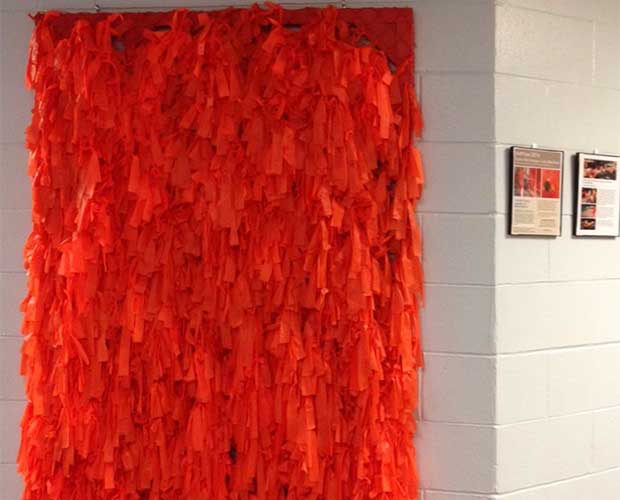
Sometimes an experience grows beyond one’s initial purpose. I had one of those enriching moments when a group of at-risk young teenaged boys came to work in my yard. After our introductions, one asked, “Why is your yard so nice?”
“I’m an artist,” I replied. “My yard is like one of my art canvases. Have you seen my ArtPrize works downtown?”
“No. I’ve never been to ArtPrize.”
“Your school has one of my ArtPrize works,” I said. “Have you seen it?” I described one of the 3-foot by 6-foot wooden panels covered with thousands of orange ribbons that had been donated to their school. “ArtPrize visitors tied 100,000 orange ribbons on Color Me Orange—Color Me Kind as a promise to live by the Golden Rule. The single panel at your school probably has about 10,000 ribbons on it.”
“That’s yours? It’s in our gym. May we see more of your artwork?”
“Later. After we are done working,” I answered.
For the next three hours, I worked alongside the boys and introduced them to plants, like hostas, day lilies, and ferns. We discussed shade plants and trees. I described the various wildlife creatures that visit our yard.
When we discovered a dead chipmunk, they wanted to know how the chipmunk died. One asked, “Did it fall out of a tree?”
“No,” I said. “Chipmunks don’t usually fall out of trees. Maybe it died of old age or disease.”
Then I went inside to bake fresh chocolate chip cookies and gather an assortment of Jones sodas while the boys finished the yard chores. We then sat at my patio table to eat; the boys did the math on how many cookies they each got and decided which color Jones soda they wanted. While they ate, I showed the boys two of my art photo books.
They listened intently to my introduction of The Scarlet Cord—my awareness work on sex-trafficking. I also showed them images from Courage Ablaze on the plight of the Congolese women and children. I told them a few stories about rebel soldiers sweeping through villages killing the men and raping the women. The boys asked more details about one of the stories, “Why did the soldiers kill the father? Did the mother see her five daughters being raped?”
“The rebel soldiers want to destroy the will of the people and break their spirits. Congo is mineral rich with gold, diamonds, and coltan,” I said. “Coltan is what you have in your cell phones and laptop computers. Eight million Congolese people have been slaughtered, and two millions women have been raped. The war is about greed.”
As our fifteen minute art discussion came to a close, the boys asked, “May we come back again? May we take the empty soda bottle as a souvenir?”
“Yes,” I smiled. I was touched that teenaged boys would be so interested in my artwork that they wanted a souvenir.
This art moment held special meaning for me too. As the boys left, I remembered that years ago this is how my dad taught me. He worked alongside me, introducing me to nature and to gardening. Now I was reproducing this same knowledge in others. One life touching another like a continuous living artwork that spans generations. Perhaps I’ll keep an empty Jones soda bottle too.






